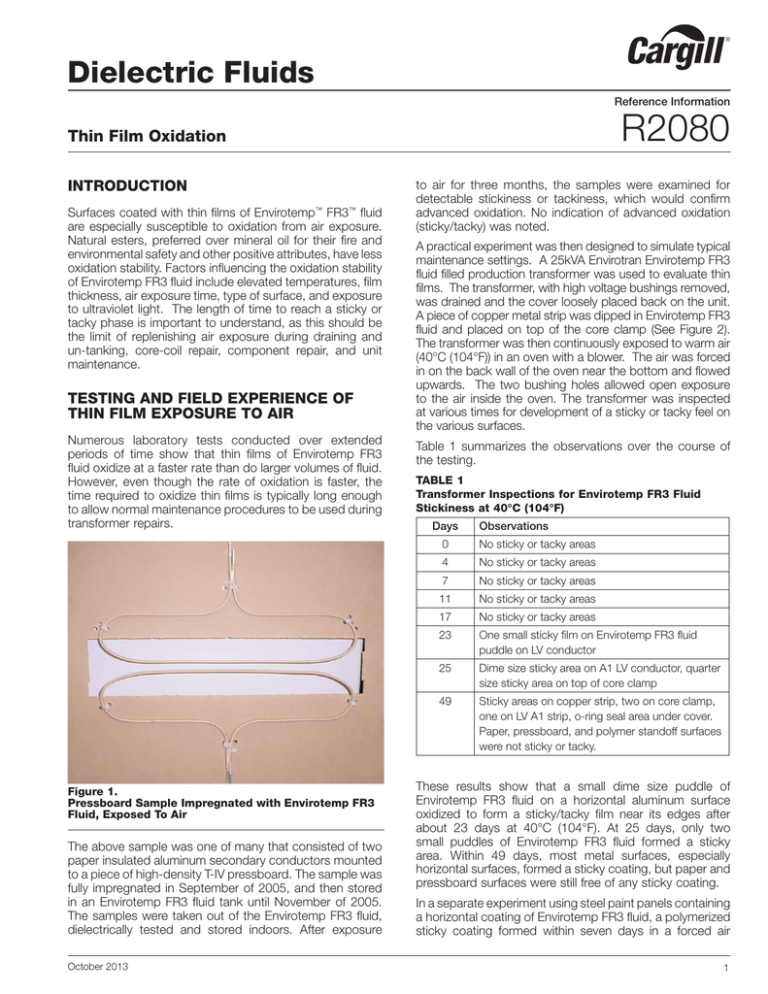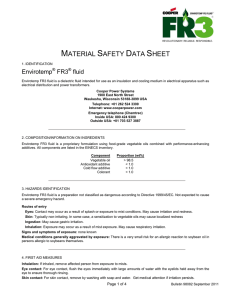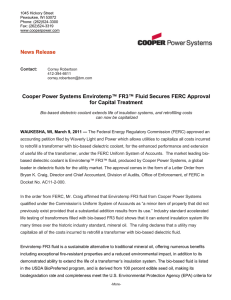
Dielectric Fluids
Reference Information
R2080
Thin Film Oxidation
INTRODUCTION
Surfaces coated with thin films of Envirotemp™ FR3™ fluid
are especially susceptible to oxidation from air exposure.
Natural esters, preferred over mineral oil for their fire and
environmental safety and other positive attributes, have less
oxidation stability. Factors influencing the oxidation stability
of Envirotemp FR3 fluid include elevated temperatures, film
thickness, air exposure time, type of surface, and exposure
to ultraviolet light. The length of time to reach a sticky or
tacky phase is important to understand, as this should be
the limit of replenishing air exposure during draining and
un-tanking, core-coil repair, component repair, and unit
maintenance.
TESTING AND FIELD EXPERIENCE OF
THIN FILM EXPOSURE TO AIR
Numerous laboratory tests conducted over extended
periods of time show that thin films of Envirotemp FR3
fluid oxidize at a faster rate than do larger volumes of fluid.
However, even though the rate of oxidation is faster, the
time required to oxidize thin films is typically long enough
to allow normal maintenance procedures to be used during
transformer repairs.
Figure 1.
Pressboard Sample Impregnated with Envirotemp FR3
Fluid, Exposed To Air
The above sample was one of many that consisted of two
paper insulated aluminum secondary conductors mounted
to a piece of high-density T-IV pressboard. The sample was
fully impregnated in September of 2005, and then stored
in an Envirotemp FR3 fluid tank until November of 2005.
The samples were taken out of the Envirotemp FR3 fluid,
dielectrically tested and stored indoors. After exposure
October 2013
to air for three months, the samples were examined for
detectable stickiness or tackiness, which would confirm
advanced oxidation. No indication of advanced oxidation
(sticky/tacky) was noted.
A practical experiment was then designed to simulate typical
maintenance settings. A 25kVA Envirotran Envirotemp FR3
fluid filled production transformer was used to evaluate thin
films. The transformer, with high voltage bushings removed,
was drained and the cover loosely placed back on the unit.
A piece of copper metal strip was dipped in Envirotemp FR3
fluid and placed on top of the core clamp (See Figure 2).
The transformer was then continuously exposed to warm air
(40°C (104°F)) in an oven with a blower. The air was forced
in on the back wall of the oven near the bottom and flowed
upwards. The two bushing holes allowed open exposure
to the air inside the oven. The transformer was inspected
at various times for development of a sticky or tacky feel on
the various surfaces.
Table 1 summarizes the observations over the course of
the testing.
TABLE 1
Transformer Inspections for Envirotemp FR3 Fluid
Stickiness at 40°C (104°F)
Days
Observations
0
No sticky or tacky areas
4
No sticky or tacky areas
7
No sticky or tacky areas
11
No sticky or tacky areas
17
No sticky or tacky areas
23
One small sticky film on Envirotemp FR3 fluid
puddle on LV conductor
25
Dime size sticky area on A1 LV conductor, quarter
size sticky area on top of core clamp
49
Sticky areas on copper strip, two on core clamp,
one on LV A1 strip, o-ring seal area under cover.
Paper, pressboard, and polymer standoff surfaces
were not sticky or tacky.
These results show that a small dime size puddle of
Envirotemp FR3 fluid on a horizontal aluminum surface
oxidized to form a sticky/tacky film near its edges after
about 23 days at 40°C (104°F). At 25 days, only two
small puddles of Envirotemp FR3 fluid formed a sticky
area. Within 49 days, most metal surfaces, especially
horizontal surfaces, formed a sticky coating, but paper and
pressboard surfaces were still free of any sticky coating.
In a separate experiment using steel paint panels containing
a horizontal coating of Envirotemp FR3 fluid, a polymerized
sticky coating formed within seven days in a forced air
1
Thin Film Oxidation
fume hood environment at room temperature. Prolonged
exposure to direct sunlight will accelerate oxidation, as will
increased temperature. These tests were developed to
address indoor service shop environments, where sunlight
is typically not a factor.
OPEN TANKS OF ENVIROTEMP FR3 FLUID:
A 200 gallon test tank of Envirotemp FR3 fluid has been
left uncovered in ambient air for approximately five years
without any processing. Samples were taken and analyzed
with results summarized in Table 2.
Figure 3.
200 Gallon Tank Filled with Envirotemp FR3 fluid
Figure 2.
25 kVA Envirotemp FR3 Fluid-Filled Transformer
2
R2080
TABLE 2
Summary of Envirotemp™ FR3™ Fluid Test Results
Envirotemp
FR3 Fluid
sampled
from 5 yr old
uncovered
tank (1/29/07)
IEEE
C57.147
Acceptance
Limits
for New
Envirotemp
FR3 Fluid
Test Performed
ASTM Test
Method
Color and
Condition
D 1500/1524
Clear,
light green
Clear,
light green
Dielectric
Strength (kV)
D 1816
(2mm)
32
≥ 35
Dissipation
Factor 25 °C (%)
D 924
1.39
≤ 0.20
Dissipation
Factor
100 °C (%)
D 924
21.0
≤ 4.0
Moisture Content
(ppm)
D 1533
322
≤ 100
Acid Number (mg
KOH/g)
D 974
0.06
≤ 0.06
Pour Point (°C)
D 97
-19
-10
Flash Point (°C)
D 92
323
≥ 275
Fire Point (°C)
D 92
357
≥ 300
Viscosity at
40 °C (cSt)
D 445
35.2
≤ 50.0
Viscosity at
100 °C (cSt)
D 445
8.3
≤ 15.0
Vol. Resistivity
(ohm-cm)
D 1169
8.2 x 1011
-
Inhibitor Content
(%)
D 4768
0.22
-
The results indicate that while the inhibitor content decreased
(having been consumed in reactions with oxygen), the viscosity did not significantly increase. This proves that volume of
fluid relative to the surface exposed to ambient air significantly
impacts the rate and degree of polymerization that occurs.
Additionally, most other key fluid property values measured
tested within the acceptable limits for new fluid.
Cargill recommends retrofilling transformers filled with
Envirotemp FR3 fluid when viscosity increases more than 10%
(approximately 38 cSt). This is well within the acceptance criteria for viscosity of new natural ester fluids, < 50cST measured
at 40 °C, per both ASTM D6971-03 and IEEE C57.147.
CAUTION: Unlike transformer assemblies
impregnated with mineral oil, hot air drying is
an unacceptable process for drying out and or
reducing power factor of assemblies already
impregnated with a natural ester fluid. For
additional drying of natural ester impregnated
assemblies, it is required to use methods of drying
that do not expose the impregnated insulation to
air to avoid polymerization of the dielectric fluid.
Consult Cargill Storage and Handling Guide (S10)
for suggestions on drying various Envirotemp FR3
fluid impregnated insulation systems deemed to
have too much moisture.
CONCLUSIONS:
Cargill has conducted many tests relative to oxidative
stability. Results show that the rate of oxidation of
thin films is slow indoors at room temperatures, but
can be accelerated by exposure to sunlight (UV light),
elevated temperature, and increased air flow. Also,
the surface type (porous vs. non-porous) affects rate
of oxidation as well. A larger concern is the rate of
moisture absorption since moisture directly impacts
dielectric strength.
Additionally, it is clear that the ratio of volume to surface
area of Envirotemp FR3 fluid exposed to air impacts
rate of oxidation. Two hundred gallons of Envirotemp
FR3 fluid in an open tank stored indoors was exposed
to ambient air for five years. Test results showed that
half of the oxidation inhibitor was consumed, but
viscosity did not significantly change. Large quantities
of Envirotemp FR3 fluid stored in uncovered tanks or
pools are significantly less affected by oxidation as
compared to thin films.
When performing indoor maintenance on Envirotemp
FR3 fluid filled transformers, expect little if any impact
of thin film oxidation for repairs requiring seven days
or less exposure to air. For those few occasions
where the repair requires more than seven days,
Cargill recommends the components or assemblies
be immersed in an Envirotemp FR3 fluid bath while
not being directly serviced, particularly important in
ambients with high humidity.
For long term storage of reclaimed components
after being immersed in Envirotemp FR3 fluid, Cargill
recommends these components be thoroughly
cleaned, and rinsed in a seed oil solvent (or mineral oil)
bath to remove any remaining thin films of Envirotemp
FR3 fluid.
3
Thin Film Oxidation
9350 Excelsior Crossing Blvd
Hopkins, MN 55343 USA
www.cargill.com/fr3fluid
© 2013 Cargill Incorporated. All Rights Reserved.



